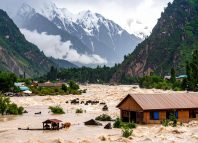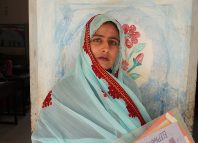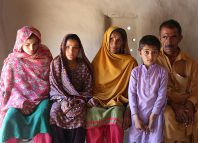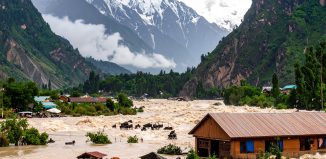Winter Emergency in Afghanistan: Urgent Action Required to Protect Vulnerable Populations
According to the United Nations Office for the Coordination of Humanitarian Affairs (UNOCHA), 22.9 million people—almost half of Afghanistan’s population—will require humanitarian assistance in 2025. Among them, 14.8 million are expected to face acute food insecurity through March 2025.[1] This situation would disproportionately impact women, as the DeFacto government’s enforcement of “gender apartheid” has resulted in a significant reduction in the national job market. Nearly 29% of women employees in the public sector, equating to approximately 116,000 jobs, have been forced to leave the workforce. [2]
Winter Weather Crisis
With temperatures plummeting to -25°C in some areas specifically mountainous area like central highland, Afghans are facing yet another harsh winter this year without adequate winterisation assistance. According to the national Shelter cluster, over 900,000 individuals in high-priority areas are at risk of not receiving essential heating assistance and winter non-food items (NFIs), which puts vulnerable groups such as women, girls, young children under five, and the elderly at an extreme risk of pneumonia, starvation and other health issues.
Among the most at risk communities currently are over 18,000 families whose shelters were damaged or destroyed by flash floods and heavy rains in 2024, leaving them without appropriate insulation or protection against the extreme cold. Additionally, more than 679,500 returnees from Pakistan (since September 2023) are living in inadequate and undignified shelter conditions, with only 15% receiving necessary support for rent, repairs, or transitional housing due to limited funding.[3]

The Meteorology Department of Afghanistan had issued alerts for heavy snowfall, significant rainfall, and strong winds across various provinces through at least Jan. 6. These provinces include Kandahar, Zabul, Uruzgan, Ghor, Sar-e-Pol, Bamyan, Daykundi, Paktika, Ghazni, Paktika, Khost, Logar, Wardak, Samangan, Balkh, Kunduz, Baghlan, Parwan, Kabul, Panjshir, Nuristan, Takhar, Badakhshan, Kapisa, Nangarhar, Laghman, and Kunar.
Since November 2024, Bamyan Province has been experiencing an intensely harsh and cold winter, with significant snowfall and critically low temperatures. Farmers in the region have reported damage to their fields and orchards due to the heavy snowfall. There are also concerns that the increasing cold may adversely affect wheat seeds, potentially impacting future harvests.[4]
The average temperatures during this period have ranged from approximately 8°F (-13°C) to 28°F (-2°C), with expectations of about 3 to 8 days of snowfall in January. These conditions necessitate warm clothing and preparedness for residents and travelers.[5]
Looking ahead, forecasts indicate that cumulative precipitation for the 2024 and 2025 winter season is likely to be below average, which could have implications for agriculture and water resources in the region.[6] Given these circumstances, residents in Bamyan Province must take necessary precautions to mitigate the impact of the extreme winter conditions and prepare for potential agricultural, livelihood challenges and food insecurity in the upcoming seasons.

Urgent Needs
Ensuring the timely delivery of winterised assistance during December and January, along with prepositioning essential supplies for the first quarter, is critical to preparedness across 209 high-priority districts in Afghanistan, including 46 flood-affected districts and 27 districts with high returnee populations. The Inter-Sector Winter Prioritisation for 2024 by the Inter-Cluster Coordination Team (ICCT), has identified 171 high-priority districts, at risk due to severe winters.
An estimated USD 603.5 million is urgently required to support urgent winter preparedness activities across Afghanistan. Including upgrades and repairs to shelter and the provision of warm clothes and blankets.[7] These activities must be implemented in the next three months to reach affected communities in a timely and coordinated manner.Urgent support such as shelter, heating materials and clothing during this time is needed to avert people’s exposure to health risks and other hazards. Women staying inside homes will be disproportionately affected by inadequate shelters, and more exposed to the cold winter, as well as to protection risks if shelters are not safe. With limited or no access to income opportunities, women and women head households are particularly at risk of poverty, food insecurity and health challenges.
Priority Areas:
- Winterisation Support including Heating & Fuel, Winter family clotting kits, and blankets.
- Cash for Food Assistance
- Multi-Purpose Cash Assistance (MPCA)
- Shelter
Community World Service Asia Response:
With the support of its partners and close community engagement, Community World Service Asia (CWSA) is monitoring the situation and plans to provide immediate winterisation support to communities most at risk of this on-going extreme winter spell. According to the shelter cluster, 8 districts includes: Behsud, Khogyani, Bati Kot, Chaparhar, Kama, Rodat, Kuz Kunar, Kot And Muhmand Dara in Nangahar are in severe need of winterisation support, where CWSA has a long presence and supports returnees and host communities.
Proposed Plan:
CWSA plans to provide winterisation support to a total of 2000 families; 1200 Households in Dowlat Sha and Mehtarlam districts of Laghman province, Behsud and Bati Kot districts in Nangarhar province, and 800 households in Yakawlang 1, Yakawlang 2, and Saighan districts of the Bamyan province.
- Cash for Winterisation Support: CWSA proposes to provide a standard winterisation package cash of $200, which includes $170 for fuel/gas and $30 for a gas cylinder, as per the ES/NFI cluster guidelines.
- Cash for Food Assistance: In line with the food security cluster guidelines, CWSA plans to provide $240 for food assistance, covering $80 per month for three months
Contacts:
Shama Mall
Deputy Regional Director
Programs & Organisational Development
Email: shama.mall@communityworldservice.asia
Tele: 92-21-34390541-4
Palwashay Arbab
Head of Communication
Email: palwashay.arbab@communityworldservice.asia
Tele: 92-21-34390541-4
Sources
Local News Agency – Tolo news
District & Provincial offices – Afghanistan
Field Teams – Bamyan and Laghman offices
UNOCHA
GiHA Report
Weather 25
ReliefWeb
[1] https://www.unocha.org/publications/report/afghanistan/afghanistan-humanitarian-needs-and-response-plan-2025-december-2024
[2] https://reliefweb.int/report/afghanistan/economic-impact-gender-apartheid-afghanistan
[3] https://reliefweb.int/report/afghanistan/afghanistan-winter-needs-and-urgent-critical-gaps-2024-2025-15-dec-2024
[4] https://tolonews.com/afghanistan-188583?utm_source
[5] https://www.weather25.com/asia/afghanistan/bamyan-province?month=January&page=month&utm_source
[6] https://fews.net/middle-east-and-asia/afghanistan/seasonal-monitor/november-2024?utm_source
[7] https://www.unocha.org/publications/report/afghanistan/afghanistan-2024-icct-winter-prioritisation-september-2024-issued-9-september-2024







